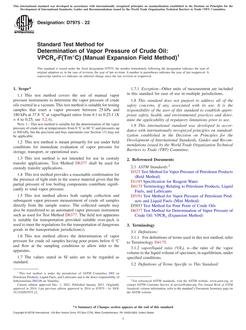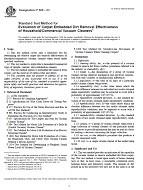1.1 This standard is a listing of the test methods commonly employed in determining the physical properties of fabrics and yarns used in the manufacture of inflatable restraints.
1.2 Fabrics used in the manufacture of inflatable restraints may be coated or uncoated, and may be comprised of spun yarns, continuous filament yarns, or a combination thereof.
1.3 Fabrics used in the manufacturer of inflatable restraints may be either flat or one piece woven. For the one-piece woven, follow the sampling section of D 5446 and the individual test method.
1.4 In Section 9, this standard lists is alphabetical order the procedures associated with conducting physical testing of the following fabric or yarn properties of concern to the design and manufacture of inflatable restraints.
| Yarn | Section |
| Denier (Yarn Number) | 9.3.1 |
| Fiber Content | 9.3.2 |
| Finish (Extractable Material) | 9.3.3 |
| Strength and Elongation | 9.3.4 |
| Twist | 9.3.5 |
| Fabric | |
| Air Permeability | 9.3.6 |
| Abrasion Resistance | 9.3.7 |
| Blocking | 9.3.8 |
| Bow and Skew | 9.3.9 |
| Breaking Force Elongation | 9.3.10 |
| Burst Strength | 9.3.11 |
| Coating Adhesion | 9.3.12 |
| Coating Weight | 9.3.13 |
| Count of Woven Fabric | 9.3.14 |
| Dynamic Air Permeability | 9.3.28 |
| Edgecomb Resistance | 9.3.29 |
| Flammability | 9.3.15 |
| Fogging (Volatility) | 9.3.16 |
| Length | 9.3.17 |
| Mass per Unit Area | 9.3.18 |
| Non-Fibrous Material | 9.3.19 |
| Odor | 9.3.20 |
| Packability | 9.3.30 |
| pH | 9.3.21 |
| Stiffness | 9.3.22 |
| Tear Strength | 9.3.23 |
| Thickness | 9.3.24 |
| Warp Size Content Residual Sizing | 9.3.25 |
| Width | 9.3.26 |
| Thread | |
| Sewing Thread | 9.3.27 |
1.5 This standard may be used in conjunction with Practice D 5427 which prescribes standard practices for the accelerated aging of inflatable restraint fabrics when comparative results of physical properties before and after accelerated aging are required.
1.6 Procedures and apparatus other than those stated in this standard may be used by agreement of purchaser and supplier with the specific deviations from the standard practice acknowledged in the report.
1.7 The values stated in either SI units or inch-pound units are to be regarded separately as standard. The values stated in each system are not exact equivalents; therefore, each system must be used independent of the other.
1.8 This standard does not purport to address all of the safety concerns, if any, associated with its use. It is the responsibility of the user of this standard to establish appropriate safety and health practices and determine the applicability of regulatory limitations prior to use. See Note 3.
Product Details
- Published:
- 04/10/2002
- Number of Pages:
- 5
- File Size:
- 1 file , 43 KB
- Redline File Size:
- 2 files , 82 KB


